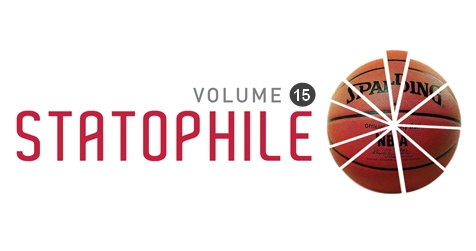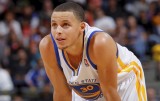The myth of the hot hand
While this study was presented at the Sloan Sports Analytics Conference two years ago, I reviewed it again during this year’s conference and thought it was worth reviewing here. Sandy Weill (who presented the “Optical Tracking” session that I reviewed yesterday), along with John Huizinga (University of Chicago Professor – and Yao Ming’s agent) published a very interesting study dismissing the concept of a “hot hand”.
Why do I bring this up now? The study doesn’t appear to be well known to many announcers/media/fans and the Raptors/Nets game on Saturday emphasized that point.
What’s a “hot hand”?
Announcers, media and fans (and video games!) often refer to a player as “hot” (“he’s on fire!“) and demand teammates continually feed him the ball.
What did the authors find?
There is no evidence of “hot hand” exists, but NBA players act as though they are hot. The following is verbatim from their presentation:
- After making a jump shot, they take harder shots, lowering their field goal shooting 3.5 percentage points.
- If everyone on the team behaves this way, it costs the average team 4.5 wins per season
Findings on offensive behaviour changes:
- After making a jump shot, players shoot 16% sooner than after a missed jump shot.
- After making a jump shot, players shoot their team’s next shot 34% of the time, as opposed to 25% of the time after a missed jump shot.
- Both of these effects are much stronger for point guards and swingmen.
Why do I bring this up?
At a point in the third period of the Nets/Raptors game on Sunday, the Raptors’ colour commentator declared (and I’m paraphasizing) Andrea Bargnani had the “hot hand” and his teammates have to get him more shots. My immediate response? This.
Here was Andrea Bargnani’s shot chart in the third quarter:
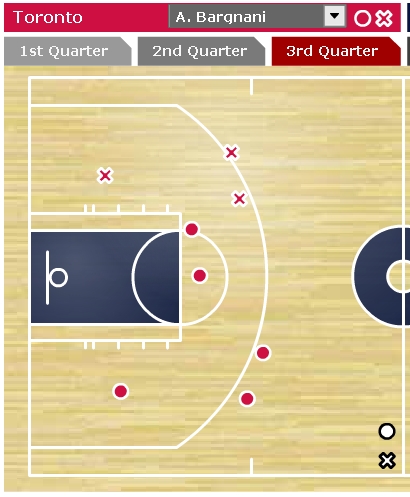
Five for eight, with two threes, is certainly excellent production. And I don’t mean to pick on just the Raptors’ colour commentator – I’m sure 95%+ of NBA announcers would say the same thing. Several Raptors fans on Twitter were saying it.
So what happened once he had the “hot hand”?
Bargnani went 3 for 11 the rest of the game. After being “hot”, he certainly forced more shots.
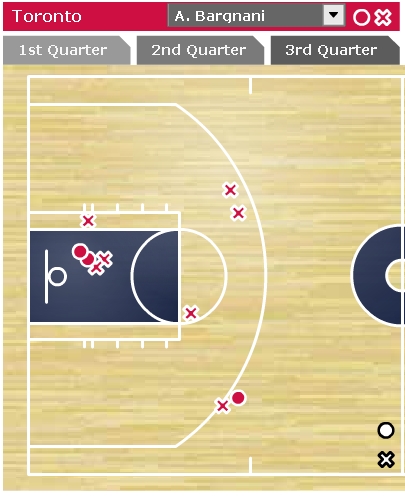
This not an indictment just on Bargnani. It’s about announcers and fans making the mistake of wanting teammates to consistently feed the hot hand.
In the same game, Demar DeRozan went 6 for 7 in the first quarter (Note: ESPN has a couple errors in this chart: it includes two James Johnson misses and one Ed Davis make).
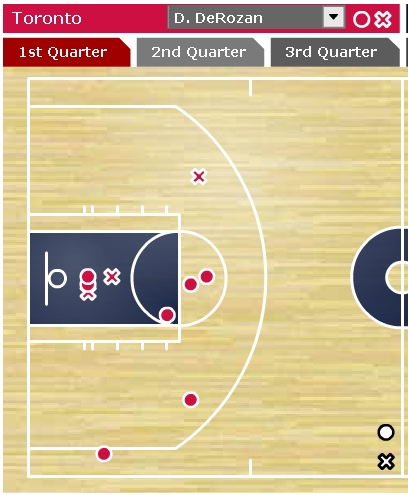
The Raptors’ colour commentator noted “young guys can absorb the travel” in discussing DeRozan’s hot start.
So what happened? He must have tired in a hurry. He missed the next four shots and went 4 for 11 until the end of regulation. Again, this is not meant as a criticism of any specific announcer (I couldn’t call 2 minutes of a game without messing up often and quoting 54 clichés). The misconceptions surrounding the “hot hand” is a general view from announcers and fans alike. Its the natural tendency for all media [“He’s had a double-double four of his last six games” when actually (most often) it should be “four of his last seven” – as everyone generally starts the “trend” at the first positive datapoint.] And yes, I have been guilty of this as well.
An important note
Huizinga and Weil note “We cannot see a mechanism in which the offensive players behaviour is unchanged but the opponents defend the player more closely (needed to explain the reduced field goal percentage) that would lead to a shorter time between shots for the player. If the defense plays him tighter, at the margin, he should need to find a shot.”
I disagree with the authors here. I do believe that the player and his teammates are the largest culprits in taking the shot sooner (implying they are rushing it somewhat), but I do not think we can conclude the defender is not guarding the player tighter. Simply imagine the opponent’s coach after a player shoots, say 6 for 7, over a stretch. After a long list of obscenities, a coach would end with “either guard him tighter or your sorry a** is coming to he bench” and/or “player y, when you see him at position z, double team him”. Indeed, at this year’s conference, Weil noted (during his “What Optical Tracking Data Can Say About NBA Field Goal %” session) the second closest defender makes a difference too (i.e. double teams or soon to be double teams).
So what do we do with these conclusions?
Coaches: refrain from forcing the ball to the “hot hand”. Make it a game theory problem. If the opponent is going to put more resources on your “hot hand”, then other players should be more open. Have the ball go through the hot hand, but ensure they keep it moving. Did I mention Weill’s “Optical Tracking” session also concluded that shots immediately following a pass are more successful, even when controlling for distance and defensive positioning? No? Probably a good time to.
Players: This is hard to do, but don’t force the issue when you’re “hot”. Chances are everyone else knows it and will adjust. Be patient. Look for that open man. Winning basketball games makes you the hero.
Announcers/Media/fans: Make the smart comment – that the opponents’ will be focused on the hot hand and its best for them to counteract these adjustments. Praise the hot hand for identifying this and moving the basketball.
Questions? Email me: tomliston@gmail.com or find me on Twitter.
One great event. One great charity. The Team Up Foundation’s one4one event featuring all the athletes from the Toronto Maple Leafs, Raptors, Marlies and FC all in one place. Enjoy cocktails, entertainment, food, and mixing & mingling with your Toronto teams at the hottest sports bar in North America! See www.liston.ca for details.



